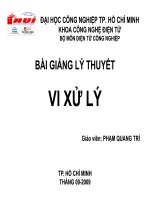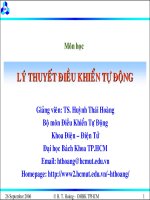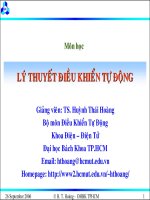BÀI GIẢNG LÝ THUYẾT DỊCH TUẦN 1
Bạn đang xem bản rút gọn của tài liệu. Xem và tải ngay bản đầy đủ của tài liệu tại đây (1.86 MB, 50 trang )
Week 1
- Session 1: Overview of Translation
- Session 2: The Process of Translation
MA. LUONG BA HUNG-0977221636
Session 1: Overview of Translation
1.1 What is translation
1.2 Why is translation
1.3 History of translation
1.4 The dynamics of translation (Peter New mark)
1.5 Translation theory
1.6 Pre-translation considerations
MA. LUONG BA HUNG-0977221636
1.1 What is translation
•
Translation is rendering the meaning of the text into another language in the way that the author
intended the text. (Peter Newmark)
•
Translation is the replacement of textual material in one language (source language) by equivalent
textual material in another language (target language). ( JC Catford)
•
Translation is the process of changing sth that is written or spoken into another language (Oxford
advanced learner’s dictionary)
MA. LUONG BA HUNG-0977221636
1.2 Why is translation
MA. LUONG BA HUNG-0977221636
The Importance of Translation
In this era of globalization where mostly everyone wants to
explore something new each moment, it becomes impossible
to actually avoid how important translation is. We all do
realize that translation is not just a way of converting words
into other words but it’s a complicated and a very crucial way
of explaining things in a way that its actual meaning is
delivered without harming its origin. Translation also carries
one culture to the other altogether in all around the world.
MA. LUONG BA HUNG-0977221636
Communication is the key of any successful relation, business or in fact
anything, you are nothing if you cannot communicate well and so here
the role of a translator becomes more crucial and very important. Just
imagine if you are hungry and you want eat something but your menu
card is in Turkish language, what will you do? Move out hungry? Or
you will take help of Translator who will translate English to Turkish
language and hence you can order something to eat for you.
Translation to Turkish or translation in English here is more than a
way of expressing what you needed and hence it signifies the
importance of translation.
MA. LUONG BA HUNG-0977221636
Important for MNC’s:
All the multinational companies would have been in a huge loss if they would have ignored the vitality of translation
and the power of lingual differences. MNC’s are the biggest example of how trade is done in other countries with the
help of Translations. China wouldn’t have been a leading economy if they wouldn’t have adopted translators in
different languages.
For a Nation:
It is most significant for every nation to maintain a proper interchange of information, technology and everything
else, which is impossible without a Translation service. Suppose if there was no way of understanding each other’s
languages then how things would have been turned out to be! But thankfully, with the help of translators today we
know how to say hello in so many languages, and how to say good bye as well.
MA. LUONG BA HUNG-0977221636
For cultural aspects:
Suppose if you want to travel across the world to understand different cultural values, how you will interact with
their people when you don’t even understand what they say. It is impossible to exchange cultures without
understanding each other’s views and significance of their culture. We will be in complete loss, if we do not
understand the importance of translation today.
So friends, as you can notice, these are the certain things that truly demonstrate how a translation service should
be adopted after all.
MA. LUONG BA HUNG-0977221636
1.3 History of translation
•
The first trace of translation dates from 3000 B.C, during the Egyptian Old Kingdom, the area of the First Cataract, Elephantine,
where inscriptions in two languages have been found.
•
It became a significant factor in the West in 300 BC Luther's Bible translation in 1522 laid the foundations of modern German.
MA. LUONG BA HUNG-0977221636
1.3 History of translation
•
In the 19th century translation was mainly a one-way means of communication between prominent men of letters and, to a lesser
degree, philosophers and scientists and their educated readers abroad.
•
The 20th century has been called the “age of translation” to which one may add “and interpreting”. International agreements
between states, between state, public and private organizations are now translated for all interested parties, whether or not the
signatories understand each other's language. The setting up of a new international body, the constitution of an independent
state, the formation of a multinational company, gives translation enhanced importance.
MA. LUONG BA HUNG-0977221636
1.4 The dynamics of translation (Peter Newmark)
MA. LUONG BA HUNG-0977221636
MA. LUONG BA HUNG-0977221636
A text is pulled in ten different directions, as follows:
1. The individual style or idiolect of the SL author. When should it be (a) preserved, (b) normalized?
2. The conventional grammatical and lexical usage of this type of text, depending on the topic and the situation.
3. Content items referring specifically to the SL, or third language (i.e. not SL or TL) cultures.
4. The typical format of a text in a book, periodical, newspaper, etc., as influenced by tradition at the time.
5. The expectations of the putative readership, bearing in mind their estimated knowledge of the topic and the style of language they
use, expressed in terms of the largest common factor, since one should not translate down (or up) to the readership.
MA. LUONG BA HUNG-0977221636
A text is pulled in ten different directions, as follows:
6, 7, 8. As for 2, 3 and 4 respectively, but related to the TL.
9. What is being described or reported, ascertained or verified (the referential truth), where possible independently of the SL text
and the expectations of the readership.
10. The views and prejudices of the translator, which may be personal and subjective, or may be social and cultural, involving the
translator's “group loyalty factor”, which may reflect the national, political, ethnic, religious, social class, sex, etc. assumptions of
the translator.
MA. LUONG BA HUNG-0977221636
1.5 Translation theory
•
Linguistic Theory of Translation (by Catford, Nida) focuses on finding the equivalence (of meaning,
grammar, content...)
•
Functionalist Theories of Translation (German school) by K.Reiss, Neubart, Wilses, Vermeer, Skopco)
do not pay attention to source texts. Their main aim is what we do with translation.
•
Translation as Cultural Events Theory (by Mary Snell Hornby) sets up an integrated approach to
translation.
MA. LUONG BA HUNG-0977221636
1.5 Translation theory
•
Manipulation School of Translation (by Susan Bassnett) (School of UK and Holland) points out the
power of translation.
•
Deconstructionist Theories (by Edwin Gentzler) (USA) forget source texts and regard translation as
the second original.
•
Culture and Context Theories (by Peter Newmark) focus on culture and context during the translation
process. As this is the most suitable for undergraduate students, the theory, which is introduced
below, is based on Peter Newmark's
MA. LUONG BA HUNG-0977221636
Translation theory
Translation theory, in a narrow sense, is concerned with the translation method appropriately used for a
certain type of text, and it is therefore dependent on a functional theory of language.
However, in a wider sense, translation theory is the body of knowledge that we have about translating,
extending from general principles to guidelines, suggestions and hints.
MA. LUONG BA HUNG-0977221636
What translation theory does is
What translation theory does is,
first, to identify and define a translation problem (no problem - no translation theory!);
second, to indicate all the factors that have to be taken into account in solving the problem;
third, to list all the possible translation procedures; finally, to recommend the most suitable translation
procedure, plus the appropriate translation.
MA. LUONG BA HUNG-0977221636
1.6 Pre-translation considerations
1.6.1 READING THE TEXT
You begin the job by reading the original for two purposes: first, to understand what it is about; second,
to analyze it from a “translator's” point of view. Understanding the text requires both general and close
reading. General reading is to get the gist. Close reading is required, in any challenging text, of the
words both out of and in context.
MA. LUONG BA HUNG-0977221636
1.6 Pre-translation considerations
1.6.2 THE INTENTION OF THE TEXT
The intention of the text represents the SL (source language) writer’s attitude to the subject matter. Two
texts may describe a battle or a riot or a debate, stating the same facts and figures, but the type of
language used and even the grammatical structures (passive voice, impersonal verbs often used to
disclaim responsibility) in each case may be evidence of different points of view.
MA. LUONG BA HUNG-0977221636
1.6 Pre-translation considerations
1.6.3 THE INTENTION OF THE TRANSLTOR
Usually, the translator's intention is identical with that of the author of the SL text. But he may be
translating an advertisement, a notice, or a set of instructions to show his client how such matters are
formulated and written in the source language, rather than how to adapt them in order to persuade or
instruct a new TL (target language) readership. And again, he may be translating a manual of
instructions for a less educated readership, so that the explanation in his translation may be much larger
than the “reproduction”.
MA. LUONG BA HUNG-0977221636
1.6 Pre-translation considerations
1.6.4 TEXT STYLES
Following Nida, we distinguish four types of (literary or non-literary) text
1.
2.
3.
4.
Narrative: a dynamic sequence of events, where the emphasis is on the verbs or, for English,
“dummy” or “empty” verbs plus verb-nouns or phrasal verbs.
Description, which is static, with emphasis on linking verbs, adjectives, adjectival nouns.
Discussion, a treatment of ideas, with emphasis on abstract nouns (concepts), verbs of thought,
mental activity (“consider”, “argue”, etc.), logical argument and connectives.
Dialogue, with emphasis on colloquialisms and phaticisms.
MA. LUONG BA HUNG-0977221636
1.6 Pre-translation considerations
1.6.5 THE READERSHIP
You should characterize the readership of the original and then of the translation, and to decide how
much attention you have to pay to the TL readers. You may try to assess the level of education, the
class, age and sex of the readership. The average text for translation tends to be for an educated,
middle-class readership in an informal, not colloquial style. All this will help you to decide on the degree
of formality, generality (or specificity) and emotional tone you must express when you work on the text.
MA. LUONG BA HUNG-0977221636
1.6 Pre-translation considerations
1.6.6 THE QUALITY OF THE WRITING
The quality of the writing has to be judged in relation to the author’s intention and/or
the requirements of the subject matter. If the text is well written, i.e., the right words
are in the right places, with a minimum of redundancy, you have to regard every
nuance of the author's meaning as having precedence over the reader's response. If
a text is well written the syntax will reflect the writer's personality - complex syntax
will reflect subtlety, and plain syntax, simplicity. A badly written text will be cluttered
with stereotyped phrases; recently fashionable general words and probably poorly
structured. In this case, you have to correct the text.
MA. LUONG BA HUNG-0977221636
Session 2: THE PROCESS OF TRANSLATION
MA. LUONG BA HUNG-0977221636









